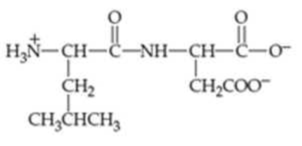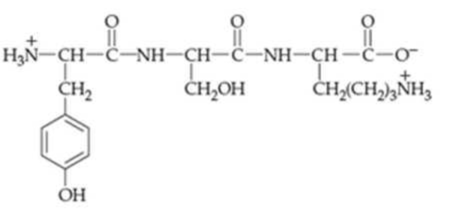
Fundamentals of General, Organic, and Biological Chemistry (8th Edition)
8th Edition
ISBN: 9780134015187
Author: John E. McMurry, David S. Ballantine, Carl A. Hoeger, Virginia E. Peterson
Publisher: PEARSON
expand_more
expand_more
format_list_bulleted
Concept explainers
Textbook Question
Chapter 18.5, Problem 18.18KCP
Identify the amino acids in the following dipeptide and tripeptide, and write the abbreviated forms of the peptide names. Copy the dipeptides, draw a box around the peptide bonds, and use an arrow to identify the α-carbon atoms. Draw a circle around the R groups, and indicate if the R groups are neutral, polar, acidic, or basic.
(a) 
(b) 
Expert Solution & Answer
Want to see the full answer?
Check out a sample textbook solution
Students have asked these similar questions
Can koch's postulates of disease causation be applied to non-microorganism disease pathogens (such as molecules)?
Here is my literature Beta Carotene HPLC analysis graph.
Can you help me explain what each peak is at each retention time?
Thank You :D
I have a literature B-Carotene HPLC graph in which showcases a retention time of roughly 23.6 and 25.1.
Please help me compare my two different Anti-Oxidant Juice graphs. (Attached)
The juices provided are: V8 Carrot Ginger Blend and V8 Original Blend
Noticing the HPLC graphs I saw no peaks for the Original Blend for B-Carotene.
However the Carrot Ginger Blend showed similar peaks --> Why is this reason?
Please explain in terms of Retention time and Area (Under Curve).
Thank You!
Chapter 18 Solutions
Fundamentals of General, Organic, and Biological Chemistry (8th Edition)
Ch. 18.2 - Prob. 18.1PCh. 18.2 - Prob. 18.2PCh. 18.3 - Prob. 18.3PCh. 18.3 - Examine the ball-and-stick model of valine in the...Ch. 18.3 - Indicate whether each of the following molecules...Ch. 18.3 - Prob. 18.6PCh. 18.3 - Prob. 18.7KCPCh. 18.3 - Prob. 18.8PCh. 18.3 - Prob. 18.9PCh. 18.3 - Prob. 18.10P
Ch. 18.3 - Prob. 18.11PCh. 18.3 - Prob. 18.12PCh. 18.4 - The proteins collagen, bovine insulin, and human...Ch. 18.4 - Prob. 18.2CIAPCh. 18.4 - Prob. 18.13PCh. 18.4 - Prob. 18.14PCh. 18.5 - Valine is an amino acid with a nonpolar side...Ch. 18.5 - Tripeptides are composed of three amino acids...Ch. 18.5 - Prob. 18.17PCh. 18.5 - Identify the amino acids in the following...Ch. 18.5 - Prob. 18.19PCh. 18.5 - Prob. 18.3CIAPCh. 18.5 - Prob. 18.4CIAPCh. 18.5 - Two of the most complete (balanced) proteins...Ch. 18.6 - Prob. 18.6CIAPCh. 18.6 - Prob. 18.7CIAPCh. 18.6 - (a)What atoms are present in a planar unit in a...Ch. 18.6 - Prob. 18.21PCh. 18.6 - Prob. 18.22PCh. 18.7 - Prob. 18.23PCh. 18.7 - Prob. 18.24PCh. 18.7 - Complete the following two sentences with either...Ch. 18.7 - Prob. 18.26KCPCh. 18.8 - Which of the following pairs of amino acids can...Ch. 18.8 - Look at Table 18.3 and identify the type of...Ch. 18.8 - In Figure 18.3, identify the amino acids that have...Ch. 18.8 - Prob. 18.30PCh. 18.9 - Prob. 18.31PCh. 18.10 - Another endoprotease is trypsin. Trypsin...Ch. 18.10 - Prob. 18.33PCh. 18.10 - Prob. 18.8CIAPCh. 18.10 - Prob. 18.9CIAPCh. 18 - Draw the structure of the following amino acids,...Ch. 18 - Prob. 18.35UKCCh. 18 - Prob. 18.36UKCCh. 18 - Prob. 18.37UKCCh. 18 - Prob. 18.38UKCCh. 18 - Threonine has two chiral centers. Draw L-threonine...Ch. 18 - Name four biological functions of proteins in the...Ch. 18 - Prob. 18.41APCh. 18 - Prob. 18.42APCh. 18 - Prob. 18.43APCh. 18 - Prob. 18.44APCh. 18 - Prob. 18.45APCh. 18 - Prob. 18.46APCh. 18 - Prob. 18.47APCh. 18 - Draw leucine and identify any chiral carbon atoms...Ch. 18 - Prob. 18.49APCh. 18 - Prob. 18.50APCh. 18 - Is histidine hydrophilic or hydrophobic? Explain...Ch. 18 - Prob. 18.52APCh. 18 - At neutral pH, which of the following amino acids...Ch. 18 - Prob. 18.54APCh. 18 - Prob. 18.55APCh. 18 - Prob. 18.56APCh. 18 - Prob. 18.57APCh. 18 - Proteins are usually least soluble in water at...Ch. 18 - Prob. 18.59APCh. 18 - Prob. 18.60APCh. 18 - Prob. 18.61APCh. 18 - Prob. 18.62APCh. 18 - Prob. 18.63APCh. 18 - (a)Identify the amino acids present in the peptide...Ch. 18 - Prob. 18.65APCh. 18 - Prob. 18.66APCh. 18 - Prob. 18.67APCh. 18 - Prob. 18.68APCh. 18 - Prob. 18.69APCh. 18 - Prob. 18.70APCh. 18 - Prob. 18.71APCh. 18 - Prob. 18.72APCh. 18 - Prob. 18.73APCh. 18 - Prob. 18.74APCh. 18 - Prob. 18.75APCh. 18 - What kind of bond would you expect between chains...Ch. 18 - Is the bond formed between each pair in Problem...Ch. 18 - Prob. 18.78APCh. 18 - Prob. 18.79APCh. 18 - Prob. 18.80APCh. 18 - Prob. 18.81APCh. 18 - Prob. 18.82APCh. 18 - Prob. 18.83APCh. 18 - Prob. 18.84APCh. 18 - Prob. 18.85APCh. 18 - Prob. 18.86APCh. 18 - Prob. 18.87APCh. 18 - Prob. 18.88APCh. 18 - Give an example of a protein that has quaternary...Ch. 18 - Prob. 18.90APCh. 18 - Prob. 18.91APCh. 18 - Prob. 18.92APCh. 18 - Prob. 18.93APCh. 18 - Prob. 18.94APCh. 18 - Prob. 18.95APCh. 18 - Prob. 18.96APCh. 18 - Prob. 18.97APCh. 18 - Prob. 18.98CPCh. 18 - Prob. 18.99CPCh. 18 - Prob. 18.100CPCh. 18 - Prob. 18.101CPCh. 18 - Prob. 18.102CPCh. 18 - Prob. 18.103CPCh. 18 - Prob. 18.104CPCh. 18 - Prob. 18.105CPCh. 18 - Prob. 18.106CPCh. 18 - Prob. 18.107CPCh. 18 - Prob. 18.108CPCh. 18 - Prob. 18.109GPCh. 18 - Prob. 18.110GPCh. 18 - Prob. 18.111GPCh. 18 - Prob. 18.112GP
Knowledge Booster
Learn more about
Need a deep-dive on the concept behind this application? Look no further. Learn more about this topic, biochemistry and related others by exploring similar questions and additional content below.Similar questions
- Calculate pH of a solution prepared by dissolving 1.60g of sodium acetate, in 88.5 mL of 0.10 M acetic acid. Assume the volume change upon dissolving the sodium acetate is negligible. Ka is 1.75 x 10^-5arrow_forwardShow a mechanism that leads to the opening of the ring below under acid-catalyzed conditions. Give the correct Fischer projection for this sugar.arrow_forwardWhat is the stereochemical relationship between B & C?arrow_forward
- Don't use ai or any chat gpt will dislike okk just use accurate information okkk okkk just solve full accurate. don't use guidelines okk just did it accurate 100% sure experts solve it correct complete solutions okkk follow all instructions requirements okkkarrow_forwardhow would you make this plot in excel?arrow_forwardwhat is the productarrow_forward
- Balance the following equation and list of coefficients in order from left to right. SF4+H2O+—-> H2SO3+HFarrow_forwardProblem 15 of 15 Submit Using the following reaction data points, construct Lineweaver-Burk plots for an enzyme with and without an inhibitor by dragging the points to their relevant coordinates on the graph and drawing a line of best fit. Using the information from this plot, determine the type of inhibitor present. 1 mM-1 1 s mM -1 [S]' V' with 10 μg per 20 54 10 36 20 5 27 2.5 23 1.25 20 Answer: |||arrow_forward12:33 CO Problem 4 of 15 4G 54% Done On the following Lineweaver-Burk -1 plot, identify the by dragging the Km point to the appropriate value. 1/V 40 35- 30- 25 20 15 10- T Км -15 10 -5 0 5 ||| 10 15 №20 25 25 30 1/[S] Г powered by desmosarrow_forward
arrow_back_ios
SEE MORE QUESTIONS
arrow_forward_ios
Recommended textbooks for you

 Biology (MindTap Course List)BiologyISBN:9781337392938Author:Eldra Solomon, Charles Martin, Diana W. Martin, Linda R. BergPublisher:Cengage Learning
Biology (MindTap Course List)BiologyISBN:9781337392938Author:Eldra Solomon, Charles Martin, Diana W. Martin, Linda R. BergPublisher:Cengage Learning Biology Today and Tomorrow without Physiology (Mi...BiologyISBN:9781305117396Author:Cecie Starr, Christine Evers, Lisa StarrPublisher:Cengage Learning
Biology Today and Tomorrow without Physiology (Mi...BiologyISBN:9781305117396Author:Cecie Starr, Christine Evers, Lisa StarrPublisher:Cengage Learning Human Heredity: Principles and Issues (MindTap Co...BiologyISBN:9781305251052Author:Michael CummingsPublisher:Cengage Learning
Human Heredity: Principles and Issues (MindTap Co...BiologyISBN:9781305251052Author:Michael CummingsPublisher:Cengage Learning


Biology (MindTap Course List)
Biology
ISBN:9781337392938
Author:Eldra Solomon, Charles Martin, Diana W. Martin, Linda R. Berg
Publisher:Cengage Learning

Biology Today and Tomorrow without Physiology (Mi...
Biology
ISBN:9781305117396
Author:Cecie Starr, Christine Evers, Lisa Starr
Publisher:Cengage Learning



Human Heredity: Principles and Issues (MindTap Co...
Biology
ISBN:9781305251052
Author:Michael Cummings
Publisher:Cengage Learning
Macromolecules | Classes and Functions; Author: 2 Minute Classroom;https://www.youtube.com/watch?v=V5hhrDFo8Vk;License: Standard youtube license